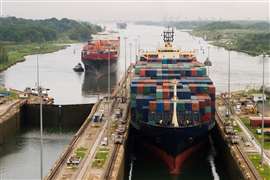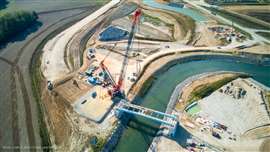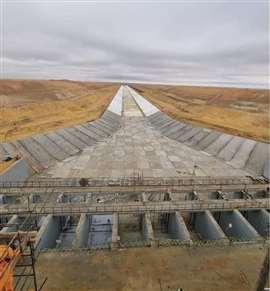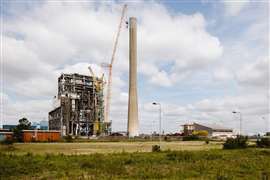Read this article in Français Deutsch Italiano Português Español
Five of the biggest canal construction projects in the world
31 January 2024
As countries look to reduce their carbon footprints and counter the dangerous effects of climate change on their lands, a new wave of canal building projects are taking place around the world. Lucy Barnard looks at five of the most high-profile.
Climate change – and the problems associated with it – is leading to a new age of canal building around the world, with a number of countries embarking on ambitious new waterway construction projects not seen for the last half century.
 A cargo ship in the Panama Canal. Image: Searegan via Adobe Stock
A cargo ship in the Panama Canal. Image: Searegan via Adobe Stock
For many, such as China and the European Union, the revival in long dormant canal building projects comes as part of an attempt to reduce both the carbon footprint and congestion associated with transporting cargo by road. In countries suffering from the effects of desertification such as Egypt and Afghanistan, meanwhile, the new programmes are part of high-profile state efforts to increase the amount of fertile farmland and bring about food security. And, in Panama, one of the most well-used waterways in the world is likely to be forced to undergo extensive expansion work due to an unprecedented dry spell which is making it difficult for ships to pass.
Construction Briefing has rounded up five of the most high-profile canal building projects taking place around the world.
The Pinglu Canal, China
In November 2022, Chinese officials announced that construction work had started three months earlier on China’s first new canal to be built since the country’s Communist Revolution in 1949.
The new Pinglu Canal, a new 132.4km long waterway, linking Nanning, the capital of the province of Guangxi with the sea, will mostly use existing water courses and will only require 6.5km of new canal construction.
The canal, which is owned by the Pinglu Canal Group Company Limited, is being built by contractor China Communications Construction Company (CCCC) and has an estimated budget of RMB72bn (US$10bn).
First Harbor Engineering, Second Harbor Engineering and other five CCCC’s subsidiaries have participated in the design and construction of the project. The project mainly includes the construction of waterways, shipping hubs, water conservancy facilities and supporting cross-river projects along the canal.
Construction work on the canal is expected to take four years.
“The Pinglu Canal will be a pioneering feat in the history of canal construction in China, as it is the largest canal of its kind. Inland ships can sail directly to seaport. Upon completion, it will become a very busy canal noted for a large volume of freights, large-tonnage ships and a large number of vessels,” said Wu Peng, an expert in the planning and design of the Pinglu Canal project, in a press statement.
In August 2023, Chinese authorities reported that more than 50 million cubic meters of earth and stone had been moved on the project. A smart cloud platform has been adopted to manage the earthworks and an ultra large self-propelled cutter suction dredger Tian Jing Hao is being used in the waterway construction.
The new canal is the first of what could be a wider canal building scheme by the Chinese government aiming to link the country’s Yangtze and Pearl rivers which mostly flow from west to east. In 2019, the government announced it was also considering works on two more canals; the Ganyue Canal, connecting Jiangxi and Guangdong and restoring the Xianggui Canal, linking Hunan and Guangxi. It said both canals could be completed by 2035.
The Seine-Nord Europe Canal, France
 Construction between Montmacq and Cambronne-les-Ribecourt in November 2023. Photo: Canal Seine-Nord Europe
Construction between Montmacq and Cambronne-les-Ribecourt in November 2023. Photo: Canal Seine-Nord Europe
The first new French waterway built since the 1970s, the Seine-Nord Europe Canal will stretch for 107km and will be 54m wide. It will link Compiègne in the Oise to Aubenchal-au-Bac in the North, allowing large barges (up to 185m long and 11.4m wide) to travel efficiently between France, Belgium and the Netherlands.
Construction of the canal will require an investment of €5.1bn. Construction costs will be shared between the French state, the European Union, French local authorities and a government loan of up to €800m. The waterway is being financed by the European Union, France and local French authorities. The construction of the canal means that barges will be able to avoid the bottleneck of the narrower Canal du Nord, making it quicker and easier to transport goods by water and reducing road traffic in France by 1 million heavy goods vehicles a year.
First approved in 2003, the project has been beset by funding squabbles and construction is being complicated by the fact that the route for the new canal runs through several WW1 battlefields where the remains of at least 100,000 soldiers have yet to be discovered.
In December 2019, the public body responsible for administering the canal, the Société du Canal Seine-Nord Europe, announced that it had awarded three separate project management contracts for work on the canal to contractors. Contracts for sectors 2 and 4 were awarded to a consortium led by French engineering and consulting firm EGIS International. Contracts for sector 3 were awarded to Dutch headquartered Arcadis and Swedish-based Sweco.
Preliminary works on the project started on site in 2017 and commissioning is scheduled for 2030.
Qosh Tepa Canal, Afghanistan
 Mullah Abdul Ghani Baradar Akhund, deputy PM for Economic Affairs in the Taliban-led government of Afghanistan visits the Qosh Tepa Canal in March 2023. Photo: Deputy Prime Minister for Economic Affairs dpmea.gov.af
Mullah Abdul Ghani Baradar Akhund, deputy PM for Economic Affairs in the Taliban-led government of Afghanistan visits the Qosh Tepa Canal in March 2023. Photo: Deputy Prime Minister for Economic Affairs dpmea.gov.af
Initially approved in the 1970s under the rule of the USSR, the Qosh Tepa Canal is an under-construction 285km-long irrigation canal which aims to divert 20% of the water from the Amu Darya River across the desert, turning 55,000 hectares of it into wheat-producing farmland and increasing Afghanistan’s total arable land by a third.
The ambitious plan, which has been implemented by the Taliban government soon after it seized power in 2021 and is being viewed as a major test of the Taliban’s ability to govern.
Certainly, the mega project is a major undertaking for the Taliban. Construction costs for the first phase of the project are thought to stand at around Afg8.2bn (US$117m) – roughly 25% of the country’s annual tax income. Moreover, as Afghanistan remains the subject of strict international sanctions, the money must come directly from the Afghan state.
Construction work on the Qosh Tepa Canal project is being handled by the country’s National Development Company which is contracting out design and construction work to Afghan construction firms. Work has been divided into three phases – two digging phases and a third of installing irrigation systems.
Officials say that more than 5,500 people have been working directly on the project, using 3,405 construction machines.
In October 2023, the Taliban government’s National Development Company reported that it had completed a first 108km phase of the 152-meter wide, 8.5-meter-deep canal, linking Kaldar District with Dawlat Abad, ahead of schedule in just 18 months.
It said that surveys and design work for a second phase of the project, stretching for 177km from Dawlat Abad district in Balkh to Andkhoi city in Faryab province, had already started. Construction for the entire project is scheduled to complete in 2028.
The government hopes that, once the work is completed, Afghanistan will become self-sufficient in wheat and other grains for the first time since the 1970s. However, the project has angered neighbouring downriver countries Uzbekistan and Turkmenistan which could both lose up to 15% of current water flow from their territories because of the canal project.
Artificial River project, Egypt
 @engazatmasr2020 (Photo: Twitter)
@engazatmasr2020 (Photo: Twitter)
Egypt is also working on an ambitious project to construct a 114km canal aimed at turning 1.2 million acres of arid desert west of the Nile Delta into arable land.
In April 2023, Egyptian President Abdel Fattah El-Sisi said that the project will be the largest project in Egypt’s history.
The Egyptian Ministry of Water Resources and Irrigation said that the initiative, is designed to mimic The Nile and will to boost food security in the country which is the largest importer of wheat in the world.
The project aims to carry agricultural wastewater from the Nile Delta to the New Delta Agricultural Wastewater Treatment Recycling and Reuse Plant in Hamam District, western Egypt.
In October 2023, Egyptian contractors Orascom Construction, The Arab Contractors, Hassan Allam Construction and Abu Dhabi headquartered water treatment specialist Metito, announced that the plant had been awarded four Guinness World Records – for largest water treatment facility, water treatment plant with the largest capacity, largest epoxy coating in a building, and largest sludge treatment plant.
The entire project has been valued at 160bn Egyptian pounds (US$5.25bn).
Panama Canal Expansion, Panama
In October, the Panama Canal Authority, the board which oversees the running of the famous Panama Canal, proposed building a new reservoir in the Indio River to bolster the dwindling water supply of the century-old canal.
The new reservoir is expected to cost nearly US$900m. The canal authority said it could start accepting bids from contractors to build it by mid-2024 with construction slated to start in 2025.
In 2023, the Canal Authority was forced to gradually reduce daily ship crossings to just 18 a day from an optimal level of 38 after water levels at Gutun Lake, the rainfall-fed principal reservoir that floats ships through the canal’s lock system have declined to unprecedented levels due to drought.
The Panama Canal, whose daily water use is triple that of New York City, relies on rainfall. More than 50 million gallons of water are lost to the sea every time a ship moves through the locks.
STAY CONNECTED


Receive the information you need when you need it through our world-leading magazines, newsletters and daily briefings.
CONNECT WITH THE TEAM











